Cars that rely on styling as a big draw can be dicey. What happens after the hype fades? What happens once the internet’s done having its collective orgasm over a new vehicle and has moved on to the next big thing? Sometimes you end up with something great like the new Toyota Prius, but sometimes you end up with something like the new Nissan Z with more flash than substance. So, what will it be for the 2023 Hyundai Ioniq 6? Thankfully, we haven’t had to wait long to find out.
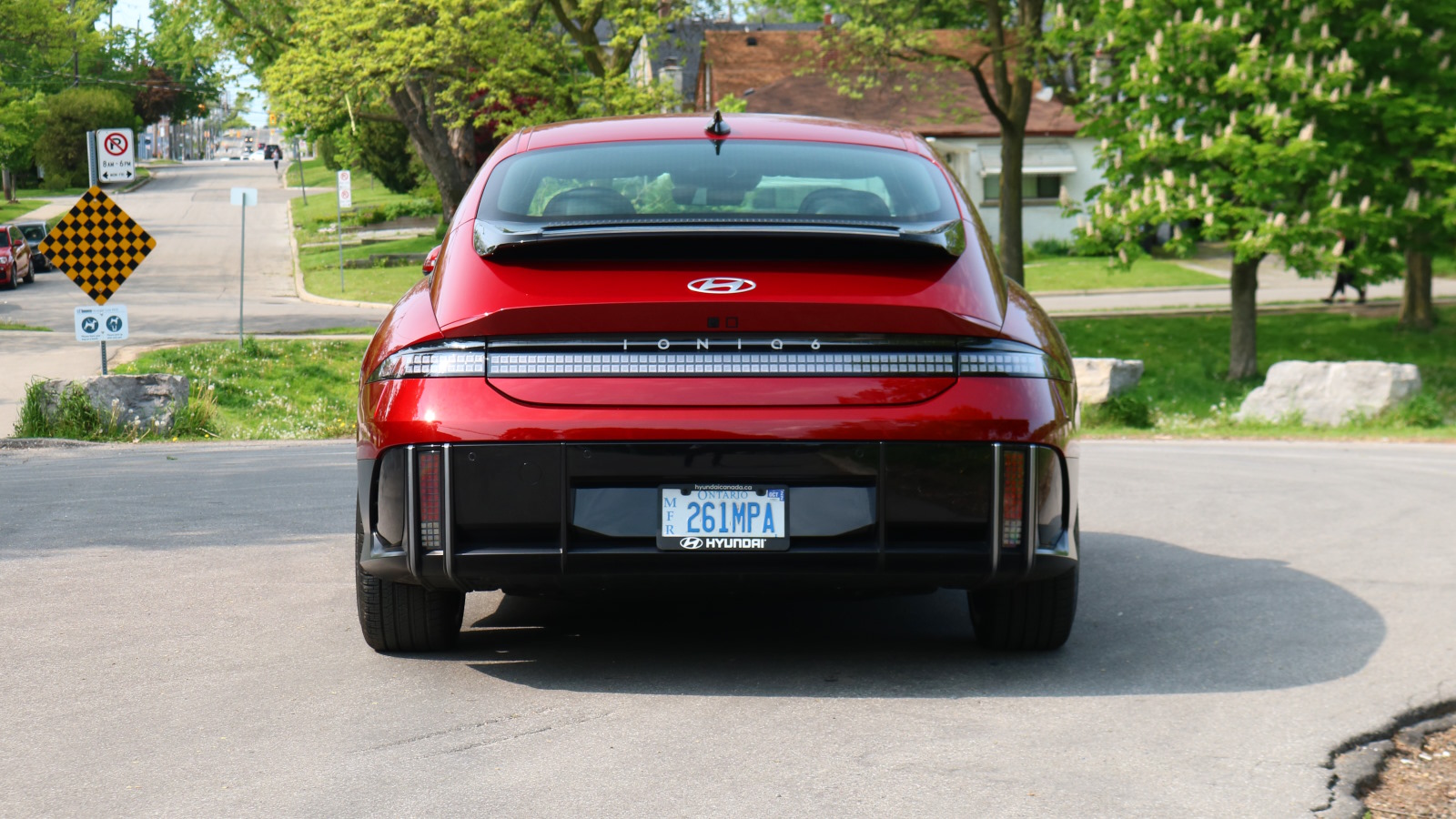
Jason has already driven the Ioniq 6, but I thought it prudent to revisit this unusual electric sedan once we’ve had some soak time. Oh, and we’re going all the way up to the tippy-top dual-motor trim with this one, so no astonishing range anecdotes here. Just a solid week of slogging over shit roads to find out if we’ve ended up with a true gem or just one of those ring pops that were popular in the late-aughts. [Ed Note: Uh, I still love ring pops. -DT].
First, a quick disclaimer: The Ioniq 6 I tested isn’t actually a Limited trim, but it essentially is. In Canada, all the top-spec equipment is bundled into one giant Ultimate Package on the Preferred AWD trim for tax credit eligibility purposes — letter of the law and all that. Otherwise, this is functionally an Ioniq 6 Limited AWD. Got it? Awesome, let’s play ball.
[Full disclosure: Hyundai Canada loaned us this Ioniq 6 for a week so long as we returned it with plenty of charge and reviewed it.]
The Basics
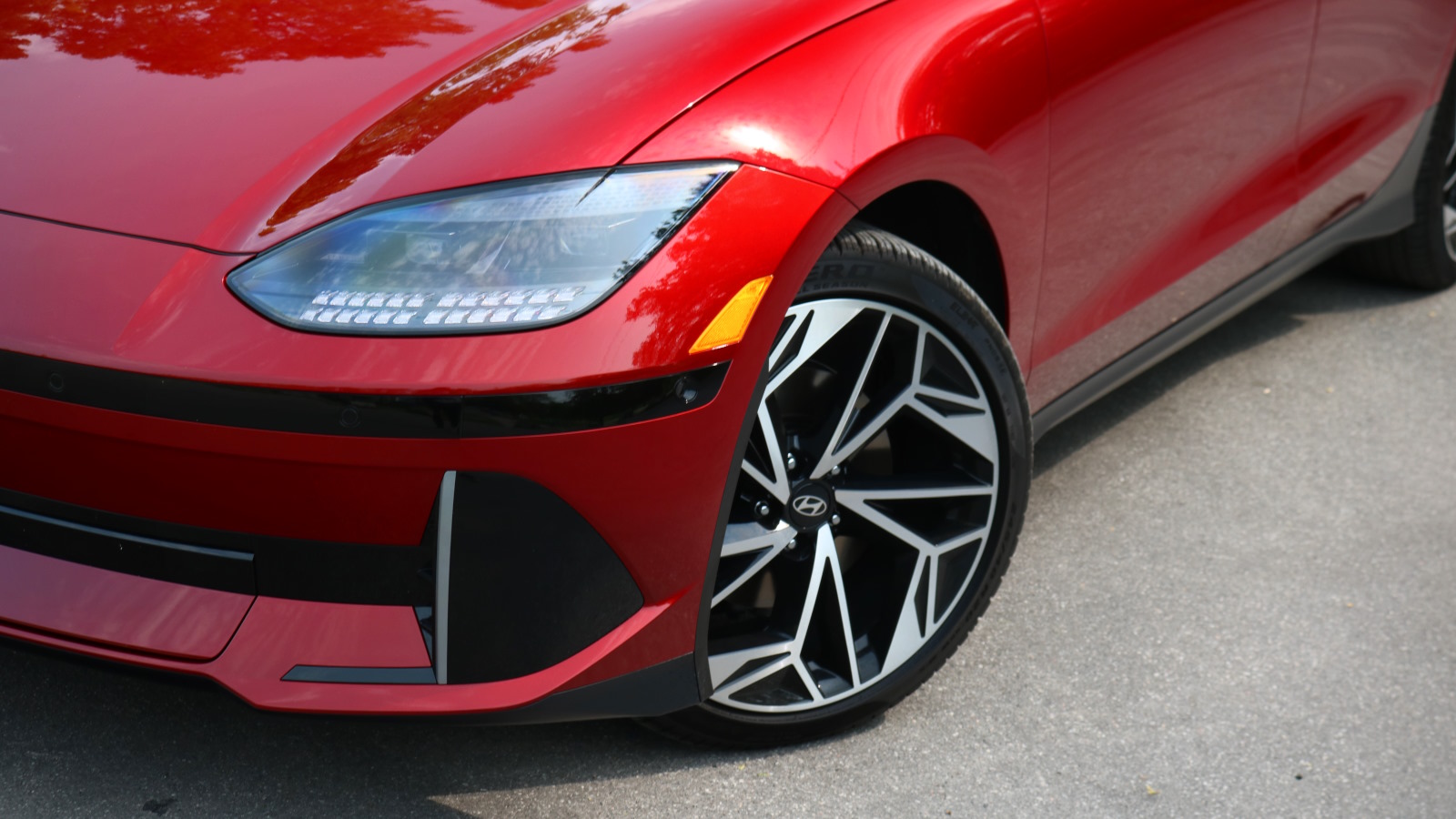
Here are the specs that you’re likely to scour a typical review article for; let’s just put them into a list to save you time:
Price: $57,215 ($66,901.70 CAD) as-tested including freight
Horsepower: 320
Electric motors: Dual permanent magnet synchronous motors
Battery: 74 kWh net usable capacity
Charging: DC Fast Charging up to 233 kW, Level 2 AC up to 11 kW
EPA Range: 270 miles (435 km)
Drive: Dual-motor all-wheel-drive
Curb Weight: 4,616 lbs. (2,094 kg)
Body Style: Large Sedan
How Does It Look?

From the front, the Ioniq 6 looks a bit like Polite Cat, or maybe the kittenbus from My Neighbor Totoro. I know humans have a habit of discerning faces from inanimate objects, but the front end of the Ioniq 6 is as friend-shaped as a hedgehog — just a good little guy that couldn’t possibly harm anyone.
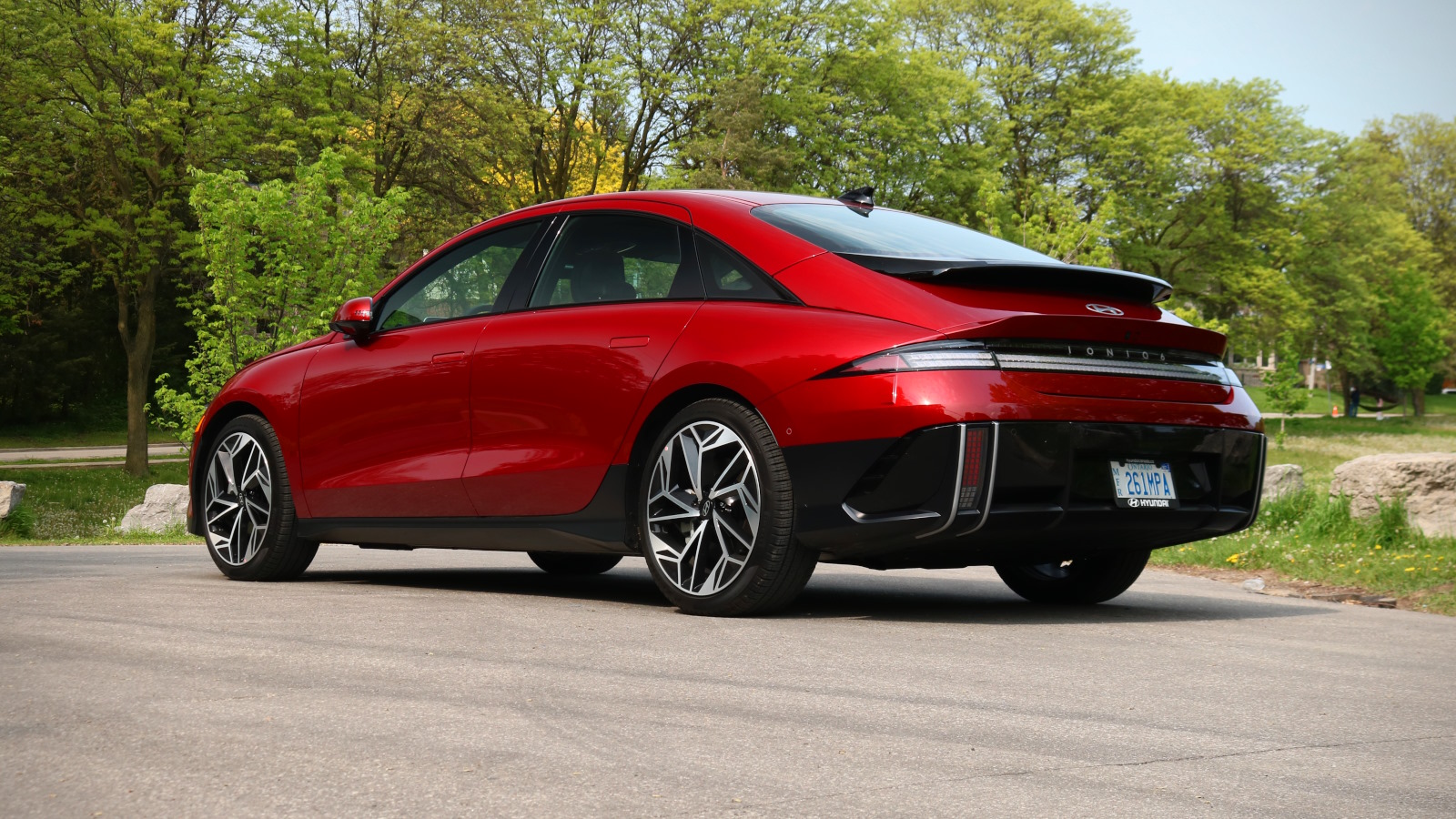
While a friendly face goes a long way to making a positive first impression, we absolutely must talk about the Ioniq 6’s, erm, assets. Out back, it’s Infiniti J30 meets air-cooled madness. Sure, the heckblende taillight may offer pixelated echoes of Infiniti’s most underrated design, but the aero situation is a Jagermeister-streaked, “Bidibodi Bidibu”-scored blur of bathtub-shaped ass-engined German sports cars from the ‘70s. Why settle for a ducktail or a whale tail when you can have both? God bless monuments to excess, especially when they’re throwbacks that can be viewed any number of ways. After all, the Merkur XR4Ti also had a dual-plane spoiler situation and those cars ruled.
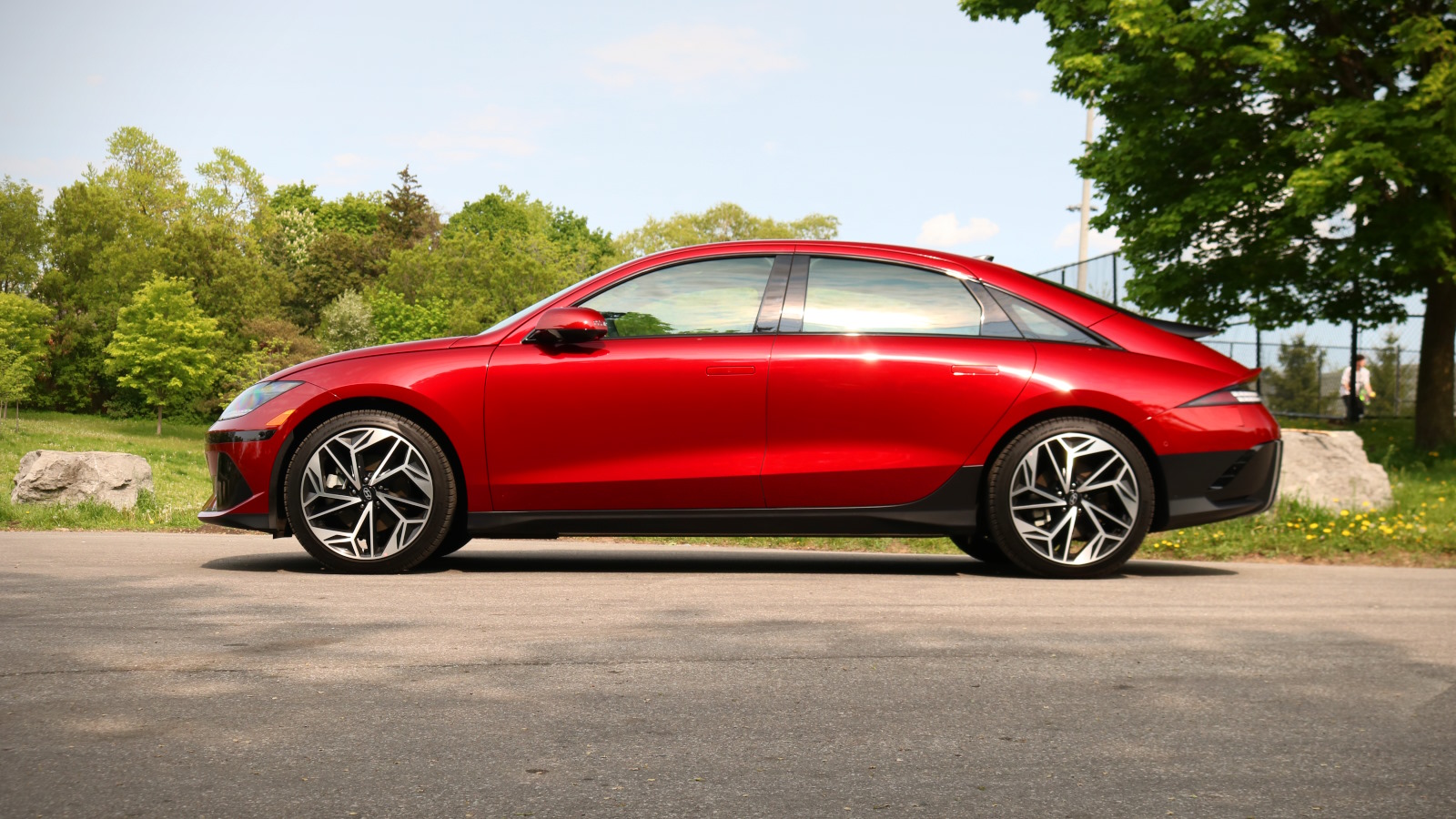
Add in a teardrop-shaped profile, and the Hyundai Ioniq 6 looks like a Flachbau Porsche 911 viewed through a kaleidoscope, Hans Ledwinka’s cyberpunk wet dream, a Volkswagen Beetle GSR rolling on molly water at EDC — take your pick. Some of my very dear friends view the Ioniq 6 as fugly compared to its Ioniq 5 counterpart. They are, of course, wrong. As handsome as the Ioniq 5 is, it won’t be chased down Terminator style through traffic by a very nice waste management professional who happens to have a 2023 Nissan Z on order. To borrow a quip from a cheesy movie: “No one knows what it means, but it’s provocative. It gets the people going.”
How About The Inside?

Because the Ioniq 6 is built on the same E-GMP platform as several crossovers, it features an unusually high seating position, a bit like an electric Toyota Crown without the ugliness. Speaking of seating, the front seats are wonderfully supportive with incredibly comfortable Volvo-like headrests you wouldn’t expect in a mass-market product. We’re talking thrones so good that Herman Miller is probably rushing to copy them. Oh, and all this comfort isn’t entirely spent on the driver. You can easily fit four fully-grown adults in the Ioniq 6 with room to spare. The flat rear floor and enormous wheelbase creates a huge cabin and really lets occupants stretch out, even with the high floor, and backseat drivers get some mad decent pillar-mounted air vents too.

Sitting back in the driver’s chair, you can’t help but marvel at the design work Hyundai’s put into the Ioniq 6’s cabin. The winged dashboard with ultra-wide air vent slat appliques comes across all mid-century modern, while the door cards feature funky corrugated material up-lit with some of the brightest ambient lighting this side of a strip club. Set that lighting to something cool and cyberpunky like purple, and you’ll have unreal vibes cruising through the city at night. It’s enough to make you wonder if the Mercedes-Benz EQE is really worth the extra money.
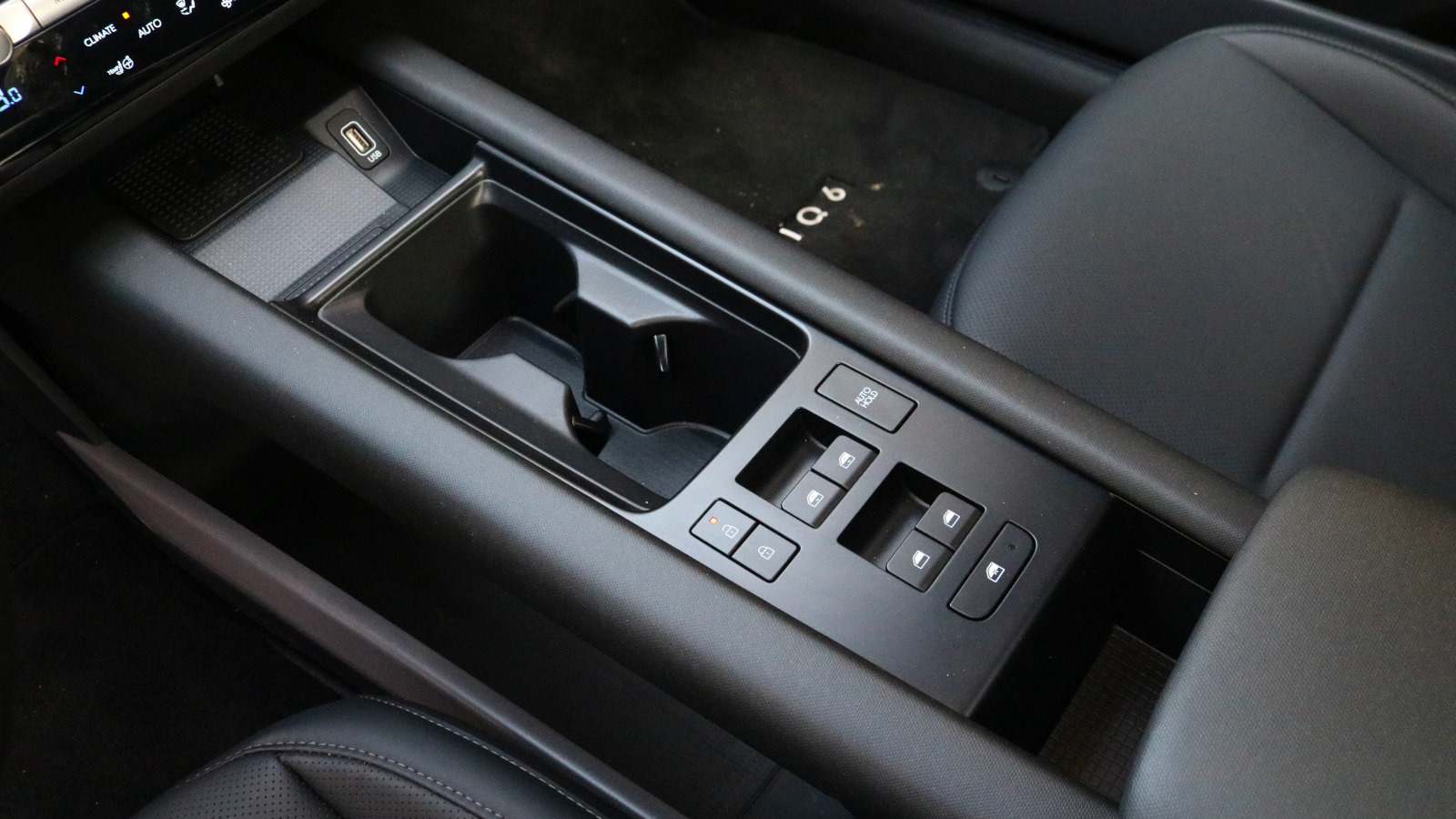
While common controls certainly aren’t as obfuscated as on a Tesla Model 3, there are a handful of oddities inside the Hyundai Ioniq 6. I’m talking window switches on the center console, a nifty twist-style e-shifter where older Toyotas put their cruise control stalks, and all sorts of stuff that would normally be JD Power’d to death on regular cars. Are push-pull window switches on the console an adjustment? Yes. Are they amusing? Absolutely, they serve up a modernized whiff of nostalgia you wouldn’t expect from such a forward-looking product. Is the e-shifter a little weird? Sure. Do you get used to it? Quickly. Look, we celebrate Citroens for all their wackiness, why can’t new cars be the same?
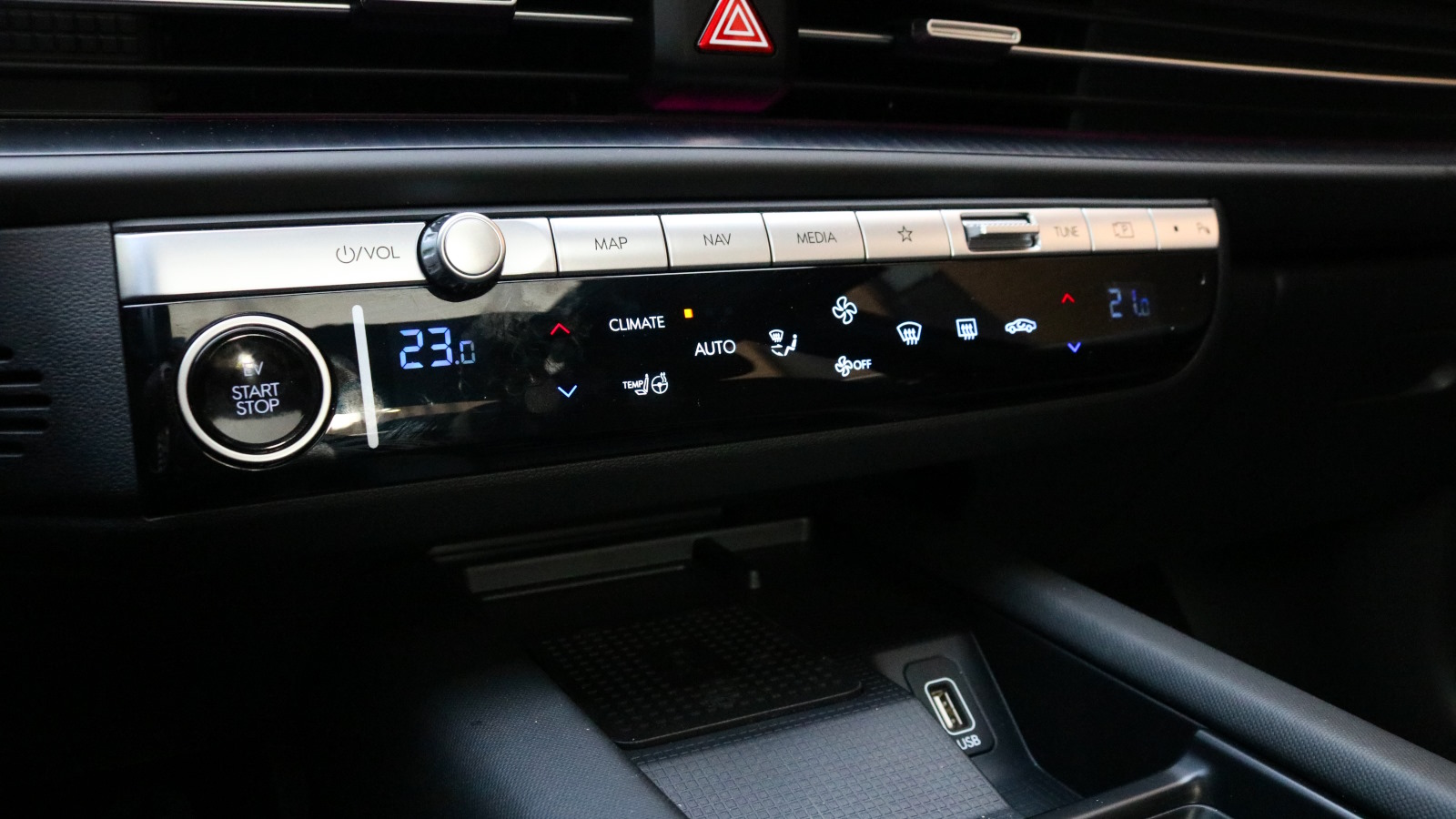
Mind you, some of the onboard technology is mildly irritating. It’s lovely to have a heated steering wheel and heated seats, but burying those functions in a sub-menu and using a capacitive touch button as a shortcut key is as agreeable as a prawn and Marmite sandwich. It’s a weird function to hide, seeing as how efficient heated seats are compared to resistive cabin heating, and you’ll find yourself wishing for top-level digital tiles at the bare minimum.
What’s It Like To Drive?

You’d be forgiven for expecting the quickest dual-motor specification 2023 Hyundai Ioniq 6 to be a Tesla Model 3 competitor in the bends. After all, the Genesis GV60 Performance I tested last year laid four patches on launch and packed an internet-friendly drift mode. Not so fast — If you were expecting any semblance of sportiness from the Ioniq 6, put your hat and coat back on, the door’s that way. The light, numb steering isn’t something to rhapsodize, nor the vagueness coming through the seat on corner entry. Even acceleration in this dual-motor car isn’t head-snapping in the real world. Sure, it leaves from the lights like a stabbed rat, but don’t let zero-to-60 in the five-second neighborhood fool you — the initial hit fades quickly. While the Ioniq 6 is still quick at highway speeds, this thing isn’t an overtaking rocket.
However, to hustle the Ioniq 6 is to miss the point completely. In the North American market, this thing is an indirect successor to the Azera full-size sedan and it absolutely nails that brief in comfort and quiet. I like comfort. In a daily driver, comfort is the new performance. Then again, I also live in an infrastructure-neglecting rust belt city with potholes that could swallow Jason’s Changli, so forgive me for lusting after motorized waterbeds for the bastard streets.

The 2023 Hyundai Ioniq 6 feels every bit of its 4,616-pound curb weight, a lithium brick of still and quiet. Hit an undulating stretch of pavement and you’ll feel the faintest whiff of secondary body motions, meaning this mid-priced electric sedan wafts like a 21st century bureaucrat-satisfying luxobarge. It’s not boaty or unwieldy, but instead incredibly serene, fitting for the Volvo-like front seats. To get a ride that truly glides in a German luxury car, you’d need to step up to a 5-Series or E-Class, and even then, the Hyundai rides better. Seriously, you could drive a fully-charged Ioniq 6 all the way to empty without growing tired, exactly what you want in a mile-munching EV. For a cherry on top, this plush sedan doesn’t fall apart in the bends either. The damping and spring rates are good enough that mid-corner bumps don’t push the front end wide like you’ve been hit with a red shell, an underrated quality for short on-ramps. Comfortable and competent in the corners? That’s winning daily driver material.
However, the drivetrain combined with the wheels and tires on this top trim do blunt the Ioniq 6’s USP. Although the long-range rear-wheel-drive boasts a Tesla Model 3-beating 361 miles of range, all-wheel-drive brings that down to 316 miles and the 20-inch alloys wallop that further to 270 miles. In the real world, I slightly exceeded the official EPA range rating, but I’d recommend going rear-wheel-drive and small-wheeled for maximum range. Really, the extra all-wheel-drive punch is unnecessary. Nice to have, but unnecessary.
Does It Have The Electronic Crap I Want?

Does it? Come on, the 2023 Hyundai Ioniq 6 has more electronic crap than you ever knew you wanted. You can sync your ambient lighting to the vehicle’s speed, choose from several propulsion sounds, heat your hands and cool your backside at the same time, and park the car from the key fob thanks to Hyundai’s Smart Park ghostride the whip mode. Sounds pretty great, yeah? Well, it mostly is, but more doesn’t always equal better.
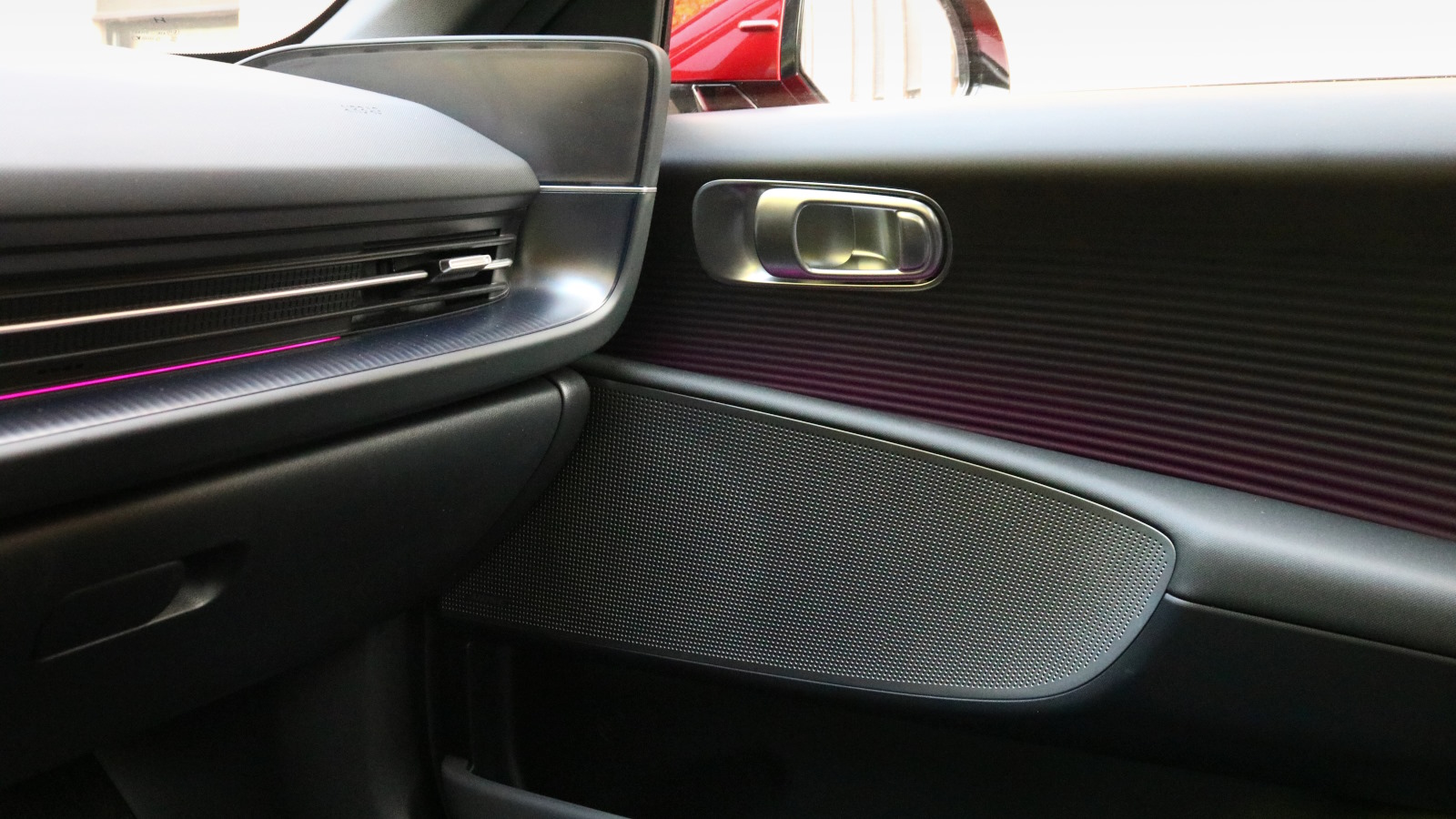
For example, the Bose audio system wouldn’t be acceptable in a $22,000 car, let alone a range-topping electric sedan. It’s the classic “no highs, no lows, must be Bose” scenario, now with even less punch! Obviously, this situation sucks for those who crave the top trim level, but it’s great incentive to save some cash and get the base trim.
Then there’s something the Ioniq 6 lacks — wireless Apple CarPlay and Android Auto. Don’t worry too much, phone mirroring is still included, but you need to use a cable. When a cheap and cheerful Chevrolet Trax includes wireless CarPlay, this pricey Hyundai not having the feature is mildly annoying. Oh, and the lack of a permanent physical home button is also annoying. However, there is some redemption here — you can set the programmable star button to take you to the home screen.
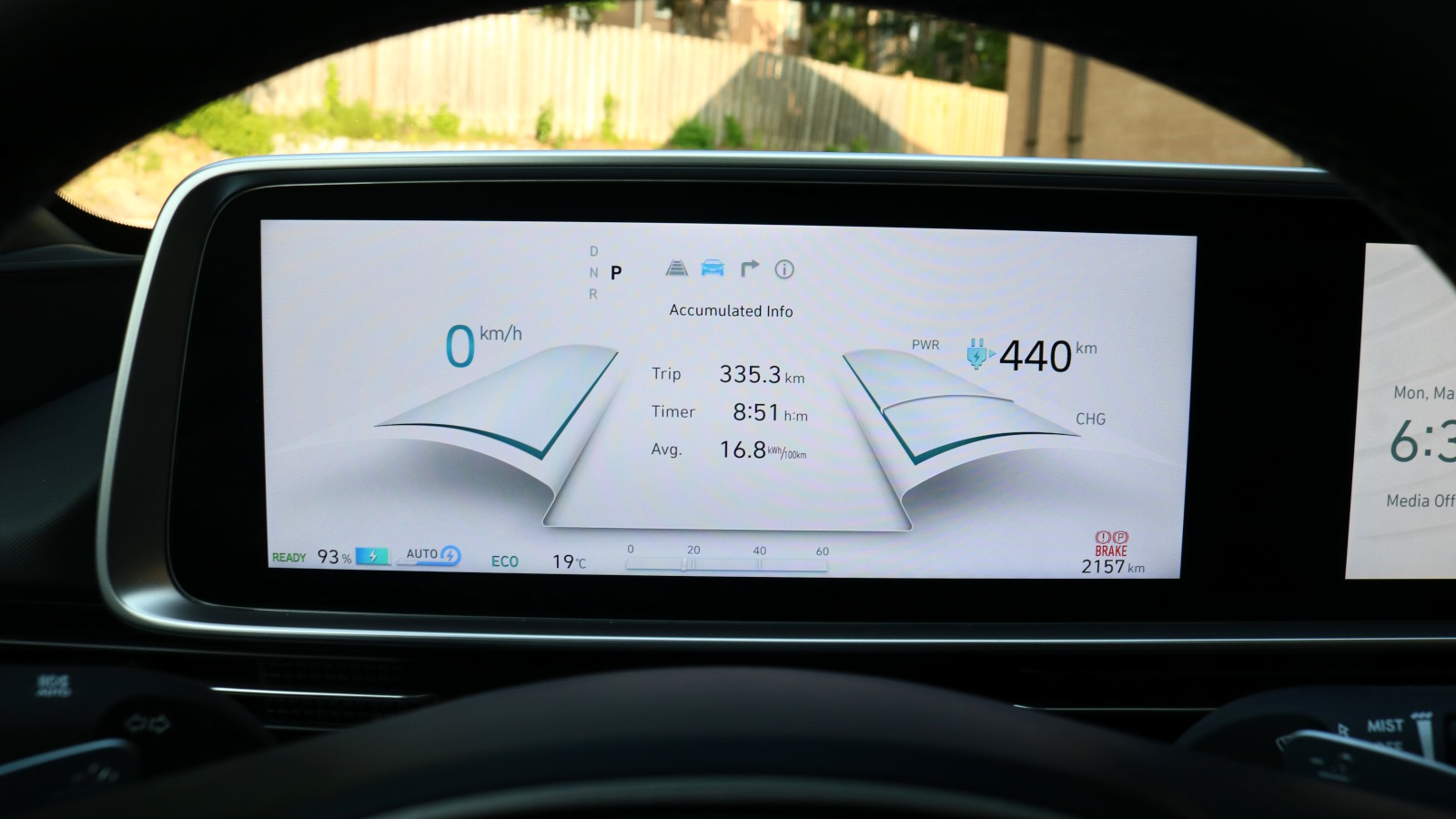
Making up for nearly all of these minor tech grips is the sheer charging speed of the Ioniq 6 AWD. Since it rides on an 800-volt architecture, it can take advantage of 350 kW charging stations, but I’m more impressed with what it can do on smaller chargers from cold. I booted the car up after a night sitting, drove five minutes to the nearest 150 kW charging station, plugged it in, and saw around 145 kW sustained on a non-preconditioned battery pack. With proper preconditioning, I wouldn’t be surprised if this thing charges faster than my iPhone.
Three Things To Know About The 2023 Hyundai Ioniq 6 Limited AWD
- This isn’t the Tesla Model 3-beating range king version.
- It’s unbelievably comfortable.
- DC Fast Charging speeds are absolutely awesome.
Does It Fulfill Its Purpose?

Upon close inspection, yes. The all-wheel-drive 2023 Hyundai Ioniq 6 isn’t a game-changer, but it doesn’t have to be. With a tantalizing mix of style, toys, range, comfort, and space, it’s the sort of electric family car people actually need. Whether you’re a 30-year-old tech enthusiast or a 75-year-old retiree with a long history of Buick sedan ownership, you’ll be able to appreciate what Hyundai’s done here. The team in Korea hit the nail on the head for what people are actually looking for in an electric sedan, and delivered a deeply-satisfying vehicle.
What’s The Punctum Of The 2023 Hyundai Ioniq 6 Limited AWD?
Good but not game-changing, it might the best new luxury sedan you can get without a premium badge.
(Photo credits: Thomas Hundal)
Support our mission of championing car culture by becoming an Official Autopian Member.

-
The 361 Mile Hyundai Ioniq 6 Is A Striking Road-Trip EV Except For One Thing
-
Watch The Hyundai Ioniq 6-Based RN22e Electric Racecar Plow Through A Massive Wall Of Straw Bales At Goodwood
-
I Rented A Tesla Model 3 To Test Against The New Hyundai Ioniq 6. Here’s How They Compare
-
Hyundai Ioniq 6 Designer Says It Was Inspired By This Groundbreaking 1930s American Car
-
The Genesis GV60 Performance Is A Tire-Frying Hypnotoad That Beats The Tesla Model Y In Many Areas
Got a hot tip? Send it to us here. Or check out the stories on our homepage.




Lots of good points, particularly the comfortable seats. Seats are where carmakers need to start when designing a vehicle.
The huge wheels can go. The whole thing looks like it’s melting, resulting in a saggy look both fore and aft. And how is the headroom in the rear seat?
Great EVs are what we need. This car is definitely headed in the right direction.
What a piece of junk
Help me understand the Bose comments.
Nice review but I’m missing a bit about luggage space and utility, especially for a family car and in a full week’s test. In Jason’s article, I can only see that it’s relatively small and with a high treshold to lift your groceries over… So I wonder how you fared with this aspect, Thomas ?
The center console window buttons are a whiff of familiarity to BMW owners (at least older 3-and-5-series BMWs).
” an infrastructure-neglecting rust belt city” – so Hamilton?
It is truly beyond me how anyone could make a vehicle with such a good drag coefficient just to ruin it with pointless 20″ wheels.
People are learning – above 200ish miles, range means little, charging speed is all, and Hyundaikia is the best non-Tesla at this.
Also I note that more or less across the board their new products just…don’t look the way they do in photographs. Sometimes better, sometimes worse, never quite right.
I’ve heard some people theorize that this is because many car designers use 3D modeling programs viewed through a 2D screen. It’s easy for the artists to make the cars look good in photos, but harder to anticipate how it’ll look through stereoscopic vision.
I think some companies still use modeling clay for this very reason.
I think of the Ioniq 5 when you say this. When it was announced I wanted one, but when I saw it in person all I could think was that it looked incredibly massive for no obvious reason.
I genuinely want to love this thing. It’s a really nice looking car, I like the weird pseudo-aircooled shape of it, and I especially like that it has serious range from a car company not owned by Melon Husk.
But ye gods the trim levels. Is there no way to get the nice interior goodies like V-tex and auto cruise control without stepping up to the SEL and its giant 20-inch range killing wheels? I hope I’m wrong here and I can build it out with option packages but like. Bleh.
Maybe I can propose a solution here: use the 20 inch tyres until they’re done and then put winter tires on them . And then buy normal tires for the summer with new rims. For winter you need bigger rims (flatter tires) to feel the road properly with winter tires on.
Um……. you don’t need bigger rims for winter tires……….?
That is a really lovely red; it looks good in that color.
I’ve seen a few Ioniq 5s at the DC charger and love how fast they charge up (compared to the slower charge architecture in my Volvo EV.) I don’t see many in northern New England, as I don’t believe any Hyundai dealers in NH are Ioniq certified.
I’m surprised that the commentary about the design didn’t end with a discussion of the purpose of that design: It may be the most aero efficient mass market car ever built.
That is why its range is so good compared to its competitors. This car could have been made a lot more slippery yet still, so there is room for improvement in future models. The larger 20″ wheels really harm the overall aero of the car and it shows in the impact on range. Drag coefficient of the most efficient configuration is 0.21, which compared to the competition is excellent, but for a car of its size, values in the mid 0.1X region are possible.
We need an inexpensive car with that sort of focus on drag reduction, as that will allow good range on a small battery pack, at least on the highway. The Aptera, even though it has 3 wheels, shows us what is possible, as it has sub-100 Wh/mile consumption thanks to its 0.13 drag coefficient and low mass. The Aptera has 3 wheels to get around various regulations because it can be classified in most jurisdictions as a motorcycle. A large car manufacturer would have the money to meet these regulations with a 4-wheeled vehicle.
We could have a 2,800-3,000 lb electric sedan only needing 120-150 Wh/mile on the highway, using a pack size of around 30 kWh to get 200 miles range, and it could have enough legroom for the occupants in the rear seat to fully stretch their legs out, and with such a small battery, components cost would go way down, allowing the possibility for the car to cost under $25k.
In a world of bland, why not be bold. These things catch my eye every time I drive by the Hyundai dealer. I’m not in love with everything about it, but overall it is good design work. I’m so glad they didn’t turn down the polygon render rate like they did with the Ionic 5.
Tell me this car was designed by people who live in a warm climate without telling me this car was designed by people who live in a warm climate.
Somewhere there has to be a bible of car interior design with a bunch of commandments like “Though shalt not put heated seat/steering wheel controls somewhere they can’t be used with gloves on”, right? I mean, there are some hard and fast rules about what you should or should not do with a car interface and this has to be right up near the top of the “don’t” list.
If said bible does not exist, the Autopian should write one and send it as an open letter to all the car manufacturers. The number or mind-bogglingly stupid interior design decisions that are still being made these days (looking at you VW, with your un-lit capacitive volume sliders) is absurd.
I believe you can, however, set those parameters from your phone before stepping outside. This doesn’t excuse the lack of a physical button, but as long as you have a modicum of forethought mostly mitigates the issue.
Does that rely on having a cell connection (not always the case when I’m out fat biking or snowshoeing in the winter) and a monthly subscription to their app?
Probably. Although some models have a button on the fob for “remote start” as well. It may be possible to have your preferred heating settings baked into the auto heating, so that when you walk up to the car the seat heaters turn on with the vehicle heat. I know of several EVs that automatically apply seat and steering wheel heat based on the ambient temperature.
The surprising thing is that I’m pretty sure Hyundai does do extensive cold weather testing. I have had two Elantra GTs, and at top settings they could still bake a ham in -40 – I’ve never experienced cars with better heating. So it’s baffling that they made this obvious mistake, they used to do shockingly good things for a cold weather environment.
Well, what is the Canadian tax eligibility requirement that this thing is tap-dancing around? We hear so much about the somewhat convoluted new US tax laws, I never stop to think about what our neighbors are doing, and if it’s any better.
I’m glad you asked! It’s a $5k after-tax federal incentive applied at the point of sale on BEVs, FCEVs, and longer-range (30+ miles of EV range) PHEVs. Country of origin doesn’t matter, but there are price caps. Cars must have a base MSRP of $55k or less, although higher trims priced up to $65,000 are also eligible. Likewise, station wagons, SUVs, vans, and pickup trucks with base models under $60,000 are eligible with trims up to $70,000 also being eligible. To get around the trim price cap on Ioniq 6, Hyundai is using an option package.
Oh wow. That sounds kind of convoluted and really semantics-driven. I think it’s better overall than the hard price cap of $55k for cars in the US and, inexplicably, $80k for ‘trucks and SUVs’, but, still sounds like it’s extremely confusing to the average person.
I really like the styling of this car, even the rear. One caveat: it looks best, in my opinion , in darker colors.
After 30 years in a Saab, console mounted window controls work just fine for me.
Not yet ready for an EV, but the single motor, small wheel model is mighty tempting.
A question: can you reconfigure the menus so that the controls you use most appear on the top screen?
“Are push-pull window switches on the console an adjustment? Yes. Are they amusing?” Going back the other way, not so amusing. had those style window switches in that location on a fiat 500c. Getting on the freeway leaving the dealership in the Jetta that replaced the totaled 500, i tried to close the windows and activated the e-brake.
This is why e-brakes (even e-e-brakes) should be on a ratcheting pull handle – you can’t accidentally fuck it up.
Not a problem with window switches, a problem with the worthless electric parking brake activated by a flippin window switch.
I like the look, and the rest sounds okay, but now all I can think of is the word “punctum.”
Right?! I totally agree! I have never heard it and it sounds inappropriate. I know a quick google search would result in me learning it means something along the lines of conclusion, or verdict, but I prefer to let my inner 12 year old giggle about it. Punctum. hehehehe. He said Punctum!
Are we only giving the range spec in km instead of miles because we know that the EPA range isn’t real to begin with?
D’oh! That should be fixed now.
Strange you mention MB in the headline, it looks like an about 5 year old MB with droopy styling I’m not really that fond of.
The side profile looks like a first-generation CLS to me…
Plenty of people have soured on the C219 CLS, but I have always liked them. This reminds me of that too, but to me that’s a good thing.
Ok so you mention quirks of Citroen, but is NO ONE going to point out how it kind of looks like a DS or C6 or any number of actual Citroen designs? NO ONE?! I’m going insane here.
It reminds me a bit of the 1935 Tatra T77A. Even has the same drag coefficient.
I made a comment recently that the Ioniq 6’s rear end looks like something Saab might do if they a.) still existed and b.) had a retro-modern design language. And I was excoriated for it…but stand by it.
This is a weird looking but attractive car.
That first square-on rear view, I was trying to decide if & why it would have bull bars on the rear. The rear does look better from an angle, though.
The 900 in today’s showdown is timely to support your point.
Since it’s a Canadian test of a Canada-spec car, I have to ask… What’s the real-world range when it’s -27C in Saskatoon?
The range is less than zero. Car only goes into reverse.
About the same as when it’s -17F in Minnesota.
Not a fair comparison. That’s only -05C in American.
(This is a Canadian $ Joke)
Car and Driver tested a Kia Niro EV with heat pump on their 70mph test during the winter. I believe they got 180 miles. EPA range is 240. Since this car is a good deal more slippery, we’re probably looking at around 200-220 miles? Google says 320km but I didn’t dig into which trim, so that tracks. It really helps range if you make sure to precondition the battery while plugged in.
Floaty Buicks were under-rated. Had one and it ruled for long trips.
RWD don’t skeer me. Glad to hear it’s a comfy cruiser. Now when’s the Kia version coming out? My local Hyundai dealer is pond scum. The local Kia dealer is way better.
I have yet to see one of these in the wild, but I certainly would like to just to see if that rear 3/4 view looks as awkward-but-interesting in real life as it does in the photos. The Ioniq 5 looks way better in person than it does in photos, so I’m hoping the 6 follows in suit.
I’ve seen a few of these in the wild, and I also drive by a Hyundai/Genesis dealership on my commute. The rear 3/4 is mostly interesting. My first time seeing both the Ioniq 5 and Ioniq 6 in the wild, I followed them as best I could because they both look so much more interesting than most of the blobs on the road.
But for the Ioniq 6, I just don’t find the design very cohesive. It’s like Hyundai’s designers were given a big bucket of features, and they dumped 90% of that bucket over the back half of the car. I’m a huge fan of the rear treatment, but something about the front–especially the hood and headlights–doesn’t jive with the rest of the design.
Interesting, and thanks for the thoughts. I can kind of see what you mean about the lack of a cohesive design, so I’ll be intrigued to see if I feel the same when I see it in the wild.
I loved the design when I first saw pictures of it, but I’ve been up close and personal with a few of them now while getting my Kona N serviced, and they’re just kind of…whelming in person. I agree that it’s not very cohesive. There are some angles that make it look great but others that make it look like a hack job.
All in all it’s an extremely here and now product and I don’t think it’s going to age all that well. Obviously I like Hyundai since I bought one and I applaud them for their willingness to throw caution to the wind and swing for the fences repeatedly…but the Ioniq 6 just wound up being a bit all over the place.
Don’t get me wrong-I don’t think it’s ugly, I just think it’s busy and current to a fault.
I had a good look a a silver one in a parking lot recently. It looks better at normal eye height than in typical photos taken from 18 inches off the ground. I also noticed less “butt droop” than in the photos (but I’m still not a fan). However, the rear 3/4 view cut lines are more obvious in person, and they’re both interesting and awkward.
The trunk lid alone has three cut lines, the taillight area has one on the side, the rear doors have two, and I’m sure the lower fascia has one or more. It doesn’t help that the tiny side window behind the C-pillar draws the eye directly to the “problem area,” and the dual spoilers contribute to the visual clutter. For a slippery car, it has a very busy back end.
It’s like all the big Lego pieces ran out by the time the designer got to the back so they had to use little pieces to make it fit together.